At the Vatican, recently, the Pope attended a concert in his honour in the Sala Clementina. This is the great double-height room which stands at the entrance to the private papal apartments; it is where Pope John Paul II’s body lay in state almost exactly five years ago. I was one of about 150 guests, at least a third of whom were cardinals, bishops and other senior clerical figures. As we arrived there was the most ornate and intricate gavotte of seat-taking, lasting a good 40 minutes.
While this eddied around us, one of the English critics and I (fortified by a clerical collar, not that that normally gets you very far in Rome) drifted towards the front and found ourselves, unchallenged, in the third row. Very satisfactory, though not recommended by scripture (we fully expected to be moved to the back).
The concert was for the Pope’s name day, of course, his festa onomastica. And Joseph was indeed the name of the day, as the piece chosen was Joseph Haydn’s Seven Last Words. This sublime sequence of slow movements was originally commissioned (in 1787) for liturgical use in Cádiz, and has gone through various transcriptions. Haydn himself made three: orchestral and choral, as well as the most familiar, the string quartet version.
This was yet another, made by the composer to the Royal Spanish Court, Jose Peris Lacasa. He has added a mezzo-soprano to the quartet, who sings phrases from the Last Words to melodic lines lifted from (or sung with) the first violin part. The musical content, as far as I could tell, was absolutely as in the original, but with the singer interweaving here and there. The singer was Susanne Kelling, the players the Henschel Quartet. These are artists of the highest international calibre, as you would expect for such an occasion. They were also playing on Stradivarius instruments lent by the Spanish court.
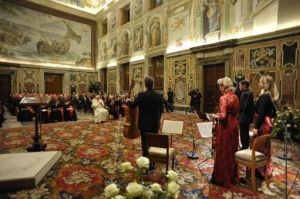 The performance was quite sensational. The acoustic of the Sala Clementina suits chamber music: it is generous, almost bathroomy, but the room is small enough not to lose any clarity or detail. The quartet played with that kind of organic togetherness you hear in the best quartets, who breathe together. That three of the four are Henschel siblings only adds to the intensity of their communication – between themselves and to the listeners. They ranged from powerful, emphatic strength to the lightest, filigree delicacy. It was entirely at the service of the music, and, I suspect, at the service of the very Last Words themselves. This performance did have a quasi-liturgical character to it.
The performance was quite sensational. The acoustic of the Sala Clementina suits chamber music: it is generous, almost bathroomy, but the room is small enough not to lose any clarity or detail. The quartet played with that kind of organic togetherness you hear in the best quartets, who breathe together. That three of the four are Henschel siblings only adds to the intensity of their communication – between themselves and to the listeners. They ranged from powerful, emphatic strength to the lightest, filigree delicacy. It was entirely at the service of the music, and, I suspect, at the service of the very Last Words themselves. This performance did have a quasi-liturgical character to it.
It is well attested that the Holy Father loves such music. His brother Georg, the priest-musician, was there to hear it too. And so, unlike so many glittering private concerts of this kind, there was aesthetic seriousness at its heart. We were all caught up in the performance, but we were also present at a very particular encounter. Here was the Successor to Peter (placed centrally and forward of everyone else, so in a sense alone) listening to the Last Words of Christ, the Christ who forgave Peter his denials and entrusted the future of his church, his sheep, to his care and love - all this mediated through music. And that care is not just some airily sweet notion, not some pious platitude, given the very pressing cares of the present situation.
If I have a quibble, it is to wonder whether this version of the Haydn was actually worth making. The original conception - a sequence of biblical quotations (the Last Words themselves), homilies and musical movements – allows for a richness of experience, thought and inspiration which does justice to the importance of the original narrative. Putting it at its crudest, there are times for words to stop. Even if you can, as it were, hear the Latin texts, or bits of them, in the musical themes, that is more of a resonance than a re-statement. The singing was committed and beautiful; but if the mezzo had sung the word "mulier" once more (in the woman, behold your son movement) I might have had an internal rupture. It would have been much more apposite to have heard the Last Words read, then allow each quartet movement to be a space for reflection.
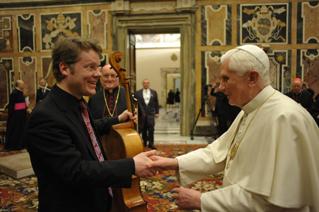 Pope Benedict gave a short address at the end, in Italian and German. He thanked the performers quite passionately. But the meat of his remarks was inspired by the music itself. The piece is “one of the most sublime examples of how to marry art and faith in music,” he said. “Hidden here is a universal law of artistic expression – the ability to communicate beauty, which is also good and true, through a medium of sense.” This applies to the other art forms, he added, and is “the same law that God followed to tell us of himself and his love: he was born in our flesh and has created the greatest masterpiece of all creation, the one mediator between God and men, Jesus Christ.”
Pope Benedict gave a short address at the end, in Italian and German. He thanked the performers quite passionately. But the meat of his remarks was inspired by the music itself. The piece is “one of the most sublime examples of how to marry art and faith in music,” he said. “Hidden here is a universal law of artistic expression – the ability to communicate beauty, which is also good and true, through a medium of sense.” This applies to the other art forms, he added, and is “the same law that God followed to tell us of himself and his love: he was born in our flesh and has created the greatest masterpiece of all creation, the one mediator between God and men, Jesus Christ.”
That this was a fascinating experience for me hardly needs saying: a Church of England priest invited to be part of something at the heart of the Vatican, something so small and private and rare. Quite apart from all the ecclesiastical features of interest (like seeing so many of the great hierarchs all in one place), it was irresistible to compare it with, say, such an event in Buckingham Palace. I haven’t been further than the forecourt there, as it happens, but even then we were passport-checked, cameras and mobiles emphatically forbidden and there were security personnel watching us from the roof.
Here there was much clicking and flashing of photography, with people (all women, bizarrely) walking determinedly to the front and snapping the Holy Father as he got up to receive the quartet and singer at the end. Security and protocol were done with a very light touch. The room was humming with a kind of tangible awe: febrile with anticipation for the Pope’s arrival; and tuned to his every reaction or move - whenever he stood, so did we, and clapping the while. He seemed relaxed, smiling warmly both to individuals and across the room; and strong – as he spoke, he occasionally raised his right hand in emphasis. It was a move a choreographer would recognise as real, not vague, signifying intention.
All in all, three Josephs were well served by this occasion.
- Fr Andrew Hammond is the Succentor of St Paul’s Cathedral. Before ordination he worked in the world of classical music.
- Find the Henschel Quartet on Amazon
- Find The Seven Last Words of Christ on the Cross on Amazon

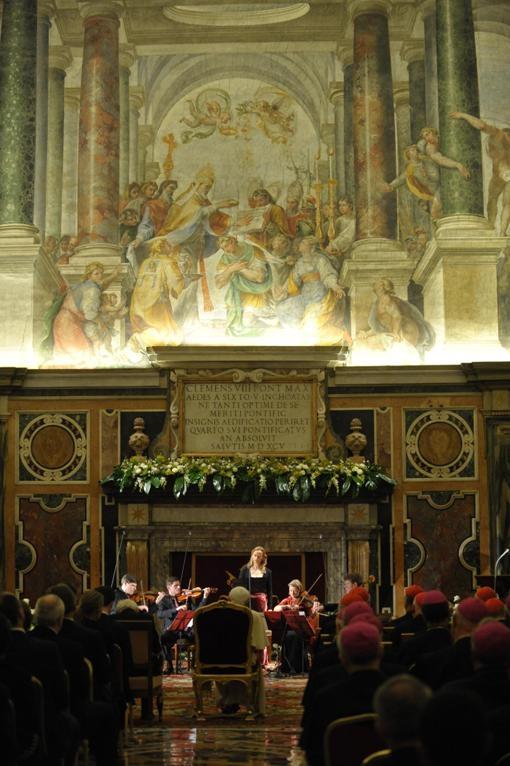

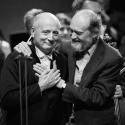









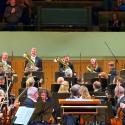
Add comment